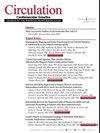1型长QT综合征的机器学习和罕见变异判定。
引用次数: 2
摘要
本文章由计算机程序翻译,如有差异,请以英文原文为准。
Machine Learning and Rare Variant Adjudication in Type 1 Long QT Syndrome.
Long QT syndrome (LQTS) is a clinically and genetically heterogenous disorder of myocardial repolarization that often manifests clinically as heart rate–corrected QT interval (QTc) prolongation on 12-lead ECG and increased risk of syncope and sudden cardiac death.1,2 Among phenotypically robust nonsyndromic LQTS cases (ie, persistent QTc prolongation ≥480 ms or Schwartz diagnostic score ≥3.5), ≈75% are anticipated to harbor a heterozygous pathogenic variant in 1 of the 3 major LQTS-susceptibility genes ( KCNQ1 /LQT1, ≈35%; KCNH2 /LQT2, ≈30%; and SCN5A /LQT3, ≈10%).2–4 As a result of established genotype-phenotype correlations, the identification of a putative pathogenic KCNQ1 , KCNH2 , or SCN5A genetic variant often enables use of genotype-guided approaches to risk stratification and clinical management.5 As such, current Heart Rhythm Society/European Heart Rhythm Association guidelines consider LQTS-specific genetic testing for individuals with a strong clinical suspicion of LQTS based on clinical/family history and electrocardiographic phenotype as a class I recommendation.6
See Article by Li et al
However, even when potentially LQTS-causative rare variants are unearthed, the presence of a ≈3% to 8% background rate of rare KCNQ1 , KCNH2 , and SCN5A nonsynonymous variants in public exomes/genomes can make assignment of causation problematic.7–9 When coupled with the increased utilization of genetic testing to probe weak or nonexistent clinical phenotypes, whether out of concern for the marked incomplete penetrance and variable expressivity observed in most sudden cardiac death-predisposing genetic heart disorders10 or a failure to recognize the probablistic rather than binary nature of genetic testing, the net result has been a surge …
求助全文
通过发布文献求助,成功后即可免费获取论文全文。
去求助
来源期刊

Circulation: Cardiovascular Genetics
CARDIAC & CARDIOVASCULAR SYSTEMS-GENETICS & HEREDITY
自引率
0.00%
发文量
0
审稿时长
6-12 weeks
期刊介绍:
Circulation: Genomic and Precision Medicine considers all types of original research articles, including studies conducted in human subjects, laboratory animals, in vitro, and in silico. Articles may include investigations of: clinical genetics as applied to the diagnosis and management of monogenic or oligogenic cardiovascular disorders; the molecular basis of complex cardiovascular disorders, including genome-wide association studies, exome and genome sequencing-based association studies, coding variant association studies, genetic linkage studies, epigenomics, transcriptomics, proteomics, metabolomics, and metagenomics; integration of electronic health record data or patient-generated data with any of the aforementioned approaches, including phenome-wide association studies, or with environmental or lifestyle factors; pharmacogenomics; regulation of gene expression; gene therapy and therapeutic genomic editing; systems biology approaches to the diagnosis and management of cardiovascular disorders; novel methods to perform any of the aforementioned studies; and novel applications of precision medicine. Above all, we seek studies with relevance to human cardiovascular biology and disease.
 求助内容:
求助内容: 应助结果提醒方式:
应助结果提醒方式:


